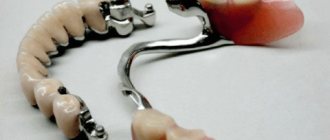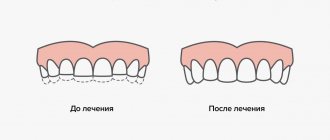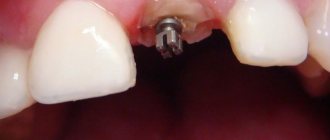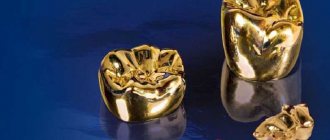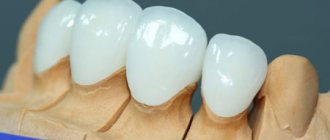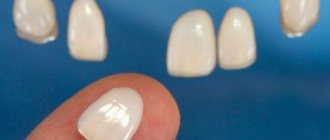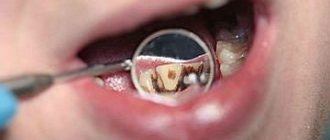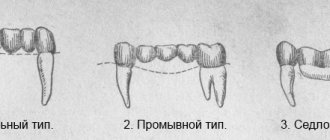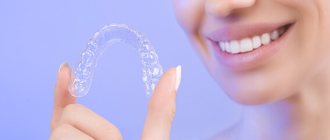From this article you will learn:
- which crowns are best for teeth,
- service life of crowns, guarantee for crowns,
- Which is better – a crown or an implant or a filling.
The choice of dental crowns for dental prosthetics usually occurs between metal-ceramics and metal-free ceramics. However, if the patient makes a choice in favor of metal-ceramics, the dentist immediately offers to choose its options. This can be either standard metal ceramics or highly aesthetic metal ceramics with the so-called “shoulder mass”.
The situation is similar with metal-free ceramics. Ceramic crowns can be made from different types of ceramic, such as zirconia or Emax glass ceramic. Which crowns are best to put on teeth will depend on many factors, for example, whether it is a front or chewing tooth, whether only single crowns or a bridge are needed, as well as on how high the patient’s aesthetic requirements are, and the size of your budget.
Prosthetics of chewing teeth: before and after photos
Clinical cases 1 and 2 –
The choice of the optimal type of crown for the front and posterior teeth will be different. Therefore, if you are more interested in prosthetics of the front teeth, read more about this in the article at the link below.
→ Which crowns are best for the front teeth?
Which crown is better: rating
Below we will talk about the best options for prosthetics of chewing teeth in different clinical situations. In Table 1 you can see which crown is better in situations where only single crowns are needed, or when we are talking about restoring a missing tooth with a bridge. The types of crowns in the table are listed from best to worst.
Dental crowns: which ones are best for chewing teeth (Table 1) –
| Single crown | Bridge prosthesis | |
| 1. | pressed ceramic E.max | made of zirconium dioxide |
| 2. | made of zirconium dioxide | combined bridge * |
| 3. | metal ceramics | metal ceramics |
| 4. | solid crown | solid bridge |
* This prosthetic option involves a combination of metal-ceramic and solid-cast bridge prosthesis. So, if from the table it has already become clear to you which crown is best to place on chewing teeth, then below you will find a detailed description of the pros and cons of the above types of crowns in various clinical situations.
1) Crowns/bridges made of zirconium dioxide –
Zirconium dioxide is a metal-free ceramic. This type of ceramic has very high strength (more than 900 MPa), which is comparable to the strength of metal, as well as a higher level of aesthetics - compared to metal ceramics. If you need to make a bridge on the chewing group of teeth, then a zirconium dioxide bridge will be the best option. But if you need to make a single crown, then zirconium is inferior to pressed glass ceramics E.max.
Pressed glass ceramics E.max has: 1) better aesthetics, 2) it has a lower risk of chipping the ceramic mass, but it cannot be used to make bridge-like prostheses resting on the distal chewing teeth. Therefore, if at least one of 6-7-8 teeth must act as supports for a bridge, the only ceramic option will be zirconium dioxide. If you need a single crown, read the next section about E.max ceramics.
Important: Most often, zirconium dioxide crowns/bridges consist of two layers. First, the zirconium frame of the future crown/bridge is milled on a computer-controlled machine (similar to the metal frame of metal-ceramics). After firing in the kiln, layers of porcelain in different shades are applied to this frame to match the color of the adjacent teeth.
The second manufacturing option is that crowns/bridges are made from monolithic zirconium dioxide (without subsequent application of porcelain layers). This option has a big advantage - there is absolutely no risk of ceramic chipping, but the aesthetics will be worse. According to statistics, when making zirconium crowns with surface application of porcelain, ceramic chips occur in approximately 10% of patients after 6 years of using such crowns.
At the same time, studies show that the risk of ceramic chips in metal-ceramic crowns is approximately 2 times lower (than in zirconium crowns with a surface layer of porcelain). And the risk of chipping with pressed E.max glass ceramics will be even lower. Therefore, to the question: which crowns are best placed on chewing teeth, the answer is that bridges are best made from monolithic zirconium dioxide, and single crowns from E.max.
→ Cost of zirconium dioxide crowns/bridges
2) Crowns made of pressed ceramics E.max –
Two single crowns from E.max – before and after photos
E.max glass ceramics are the best option for metal-free ceramics if you have the highest demands on the aesthetics of your crowns. This type of ceramic has a high strength of 400 MPa (which is less than that of zirconium dioxide), but this is more than enough for prosthetics of posterior teeth with single crowns. But for the manufacture of bridges supported by 6-7-8 chewing teeth, this strength will no longer be enough, and therefore bridges from E.max are made more often for the front teeth.
E.max comes in two main types. Firstly, this is the “E.max PRESS” material, intended for the manufacture of crowns/bridges using the pressing method at high temperature and pressure. Let's say right away that this material is much better and somewhat cheaper than the second one. Secondly, the “E.max CAD” material, which is intended for the manufacture of crowns using the milling method (CAD/CAM technology, which is also used for the manufacture of zirconium crowns).
Important: E.max crowns/bridges can be (as well as zirconium) made either monolithic or consist of 2 layers - a pressed frame on which porcelain mass will be applied. Monolithic structures have the lowest risk of ceramic chipping, while layered structures have the best aesthetics. Not long ago, a new material “E.max PRESS Multi” appeared, which makes it possible to make very aesthetic monolithic structures, from which we recommend making all single crowns for chewing teeth.
→ Cost of crowns/bridges from E.max
3) Metal-ceramic crowns/bridges –
A more budget-friendly option is metal-ceramic prosthetics. Its main aesthetic disadvantages are more modest aesthetics (compared to metal-free ceramics), the development of cyanosis of the gums around the crown, and also, over time, gum recession with exposure of the metal edge of the crown. But on the other hand, chewing teeth are not visible when you smile, which, given a limited budget, makes metal-ceramics a good choice.
Below we have posted examples of prosthetics for missing chewing teeth using metal-ceramic bridges (before and after photos).
But aesthetics should not be the only selection criterion. The fact is that for metal-ceramics, teeth are ground on different sides by 2.0-2.5 mm, and for metal-free ceramics - only 1-1.5 mm. Thus, ceramic prosthetics allows you to preserve more hard tooth tissue under the crown, which increases its service life. The cost of one metal-ceramic crown starts from 8,000 rubles (for the most budget-friendly manufacturing option, using the cheapest materials made in Russia and Belarus).
On average, for a budget option using imported economy-class materials (for example, Duceram ceramic mass, Germany) - it costs from 10,000 to 12,000 rubles for 1 crown. If the issue of aesthetics is important to you, then the production of metal-ceramics using high-quality and expensive ceramic masses Vita (Germany), Noritake (Japan), Ivoclar (Liechtenstein) will cost at least 15,000 rubles for 1 crown. It is also worth considering that the indicated price does not take into account some additional costs.
→ Calculation of the cost of metal ceramics
4) Solid crowns/bridges –
Crown bridges on the back teeth (which do not fall into the smile line) do not have to be white and beautiful. There are metal cast crowns that are made of chromium-cobalt alloy. Such crowns have the color of polished metal, or by spraying they can be given a “gold” color. They have a long service life, and besides, the teeth under them are ground to a lesser extent than under metal-ceramics.
→ Calculation of the cost of cast crowns
5) Combined bridges –
If you need to make a bridge of 3 crowns on the chewing teeth (for example, supported by the 5th and 7th teeth), the design can be made in an unconventional way... The first 1-2 crowns that fall into the smile line can be made metal-ceramic, and the distant ones 1-2 crowns can be made solid and look like polished metal. This will be somewhat cheaper, and besides, it turns out that the abutment tooth for a cast crown will be ground down to a lesser extent.
Summary -
E-max will be the best choice –
- single crowns (regardless of location),
- 3-unit bridges for the front teeth,
- veneers,
- lumineers (thickness from only 0.3 mm),
- if the patient has high aesthetic requirements,
- if the patient has high transparency of tooth enamel.
Zirconium would be the best choice –
- bridges on chewing teeth,
- bridges of 4 or more units,
- single crown supported by an implant,
- bridge prosthesis supported by implants,
- if the patient has bruxism.
Alternatives to crowns –
However, we must not forget that there are alternatives to artificial crowns. In addition to crowns, traditional tooth filling (with preliminary fixation of a pin in the root canal) can be used to restore a severely damaged tooth, and an implant can be used to restore a single missing tooth.
Which is better: a filling or a crown, a pin or a crown?
When the crown part of a tooth is significantly damaged, it can be restored not only with a crown, but also with the help of filling materials. However, there is a clear rule: if the crown of a tooth is destroyed by more than 1/2, the tooth must be restored with an artificial crown. This is especially true for pulpless teeth (from which the nerve was removed), because Such teeth become very fragile and often cannot withstand chewing pressure.
But, if the crown of the tooth is destroyed by less than 1/2, then you can use the method of restoring the tooth with filling material. If such a tooth is pulpless, then a metal or fiberglass pin is fixed in one of the root canals, which will ensure a more reliable fixation of the filling. However, keep in mind that under no circumstances should a filling with a pin be used to restore teeth whose crowns have been destroyed by more than 1/2. This is almost a guarantee that over time a fracture of the crown or root of the tooth will occur.
Restoring a completely destroyed tooth - if the crown of the tooth is completely destroyed, but if the root is strong, this is not yet a reason to remove the tooth. In such cases, restoration of the coronal part of the tooth is carried out using a stump inlay, onto which an artificial crown is subsequently fixed.
Which is better: a crown or an implant?
When it comes to replacing missing teeth with crowns, an alternative to a traditional bridge can be installing an implant. The latter has a lot of advantages over the bridge, because in this case, you will not have to grind down adjacent teeth for crowns, thereby reducing their service life.
Moreover, the cost of installing 1 economy-class implant is almost equal to the cost of a metal-ceramic bridge (especially taking into account the cost of preparing teeth for prosthetics and making temporary plastic crowns). A bridge will be better than an implant only in one situation - when the teeth adjacent to the missing one have large fillings or are pulpless (i.e., in any case, they require strengthening with artificial crowns).
Metal-free ceramics e.max installed for patients at Asti Dentistry
After
Before
Next Previous
Tooth restoration with a crown made of e.max feldspathic ceramics (highly aesthetic restoration using a refractor)
Doctor: Karapetyan Grigor Gevorkovich
MAKE AN APPOINTMENT
After
Before
Next Previous
Tooth restoration with an e.max crown (highly aesthetic restoration)
Doctor: Terekhov Alexander Petrovich
MAKE AN APPOINTMENT
Service life of dental crowns, crown warranty
The normal lifespan of dental crowns is about 8-10 years. A prerequisite for such a long service life is the quality of the therapeutic preparation of the tooth (the quality of root canal filling), as well as the accuracy of the manufacturing of the crown. Precision should be understood, first of all, as the exact fit of the crown to the neck of the tooth, which is ensured by correct preparation of the tooth for the crown, taking an accurate impression, and good work of the dental technician (24stoma.ru).
According to statistics, in 60-70% of cases, root canals are filled poorly, which leads to inflammatory complications, the need to re-treat the tooth and even remove it. Moreover, most often chronic inflammation manifests itself just after the end of the warranty period, i.e. after 1 year. For comparison, in Germany the guarantee for prosthetics is on average 3-5 years. In addition, the service life of crowns is also affected by the level of oral hygiene of patients after prosthetics.
Restoration
Ceramics can break off due to injuries, bruises, eating too rough food, bruxism, or malocclusion. The cause of the breakdown may also be a defect during the production of the prosthesis. To solve this problem, the artificial tooth should be restored or its upper shell replaced.
In the first case, the chip is polished to the optimal shape, and then filled with light-curing material. After hardening, the dentist forms fissures and tubercles on the chewing surface and removes all irregularities.
If it is decided to make a replacement, the crown is removed from the mouth. After this, the entire prosthetic process is repeated from the moment the impressions are taken.
The advantage of repair work is low price and high speed. A person does not have to walk for a long time with a broken tooth. Restoration is carried out in one visit to the doctor. If the crown was removed to make a replacement, the client is offered to use a temporary analogue. Therefore, his smile remains beautiful in any case.
How to care for crowns -
If you have single crowns on your teeth, regular floss, brush, and toothpaste after each meal will usually be sufficient. However, when it comes to bridges, hygiene difficulties may arise. After all, the latter have an intermediate part (which restores the lost tooth), and it is under it that food debris accumulates, which is difficult to remove.
Therefore, for patients with bridges, as well as with periodontal pockets in the crown area, we recommend using special irrigators (Fig. 10), which allow you to clean hard-to-reach areas of the oral cavity from food debris and accumulation of soft plaque. These devices create a pulsating stream of high-pressure water, which is supplied through a special nozzle.
Advantages of this type of product
Today, more and more people are installing ceramics on their teeth. Structures made from it are considered the most aesthetic. They are suitable for fixation in the smile area. At the same time, they are very reliable and practical, therefore they are optimal for restoring molars.
The described material is characterized by high biological inertness. It is not perceived by the human body as foreign, is not rejected, and does not contribute to the occurrence of negative chemical reactions.
Among its three main advantages, doctors name:
- impeccable appearance;
- hypoallergenic;
- durability and long service life.
If you want to have ceramic dentures installed, make an appointment at our dental clinic. We will produce crowns or bridges for you that will satisfy all your requirements and wishes.
Crowns for teeth: reviews
Unfortunately, it should be noted that patient reviews of dental crowns are more often negative than positive. And this is not due to the fact that artificial crowns themselves are bad, but due to the low quality of their dental manufacturing. The quality of crown manufacturing is influenced by many factors. And this is not only the quality of materials and equipment, but, above all, the professionalism and experience of orthopedists and therapists, as well as dental technicians.
The tooth was poorly prepared for a crown, the root canals were treated poorly - the crown and tooth needed to be redone. The impression of the teeth was poorly taken, cheap materials were used to make the crown - the crown needs to be redone again, and the tooth under the crown may begin to rot. You can read more about the stages of making crowns and what you need to pay special attention to here . We hope that our article: What are the best dental crowns reviews - was useful to you!
Sources:
1. Personal experience as a dentist, 2. “Orthopedic dentistry. Textbook" (Trezubov V.N.), 3. National Library of Medicine (USA), 4. https://www.realself.com/, 5. "Crowns and bridges in orthopedic dentistry" (Smith B.).
Prosthetics with metal-ceramics
Metal-ceramics is now not the most common material used for prosthetics of front teeth, but it owes its popularity not so much to aesthetic qualities, but to the optimal ratio of cost to appearance (of course, only with high-quality crowns, but in the Academy Dent clinic there are others cannot a priori). In addition to the relatively low cost, the significant advantages of metal-ceramic crowns are their following qualities:
- Long service life - metal ceramics will retain their beauty and effectiveness for more than 15 years.
- High aesthetic qualities that all ceramic crowns have.
But at the same time, it is necessary to note several disadvantages that distinguish metal-ceramic crowns:
- it is necessary to grind off the dental tissues sufficiently
- Due to the presence of metal in the crown, it is possible that the prosthesis will become noticeable against the background of natural teeth - it will be revealed by the lack of natural translucency. But when using metal-ceramic prosthetics for the entire dentition, such artificiality will no longer be noticeable
CL-II (glass ceramics)
The materials used in the manufacture of prostheses for this group are similar to the previous ones in their composition. But the main differences are their processing methods and structure. Glass ceramics are characterized by adding crystals to glass or growing them in it. If CL-I group crowns are made manually, then CL-II ceramics are supplied in special blocks.
Glass ceramics are divided into two types:
- CL-IIa. The composition contains a small amount of leucite-feldspathic glass (up to 50%). When the feldspar level is low, the crown material is transparent, so an additional procedure (bonding) is required during preparation. Glass ceramics are used for the same purposes as the ceramic mass of the CL-I group. Their service life is quite long. When using prosthetics, the minimum layer must be at least 0.8 mm. The main advantage is durability. This is achieved due to changes in the coefficient of thermal expansion of leucite, which significantly reduces the risk of cracks in the crown during operation.
- CL-IIb. In the ceramics of this group, the content of leucite-feldspar glass is higher than average (more than 50%). The blanks are made of glass, so they are completely transparent. The next step is growing the crystals, then grinding them and applying them to the first phase (glass). Due to this, greater strength of the material is achieved, since such processing allows the formation of an area of compressive stress. Basically, lithium disilicate (from silica), lithium dioxide, aluminum and potassium oxides, and phosphorus pentoxide are used for the manufacture of prostheses. Not long ago, lithium disilicate reinforced with zirconium (up to 10%) began to be used in prosthetics. The main advantage of this material is its durability and the possibility of performing a single restoration of any tooth.
What kind of prosthetics are made from it?
Ceramics is an inorganic, non-metallic material that is obtained by treating components at high temperatures and then cooling. The composition of ceramics is always the same, but may differ in the ratio of compounds used. The components are: nitrides, carbides, borides and metal oxides.
Over the past 10 years, ceramics have gained significant popularity in dentistry. With its help you can not only restore teeth, but also replace them.
The main feature of the material is the absence of any organic components. In terms of its structure, ceramics can have either a crystalline (or partially such) structure or an amorphous - homogeneous one. Depending on the processing method, the material will have certain properties, which in some cases makes it difficult to choose a specialist.
The following products are made from metal-free ceramics:
- A crown is a permanent dental prosthesis that completely replaces a damaged tooth;
- An inlay is a miniature prosthesis that resembles a regular filling, with the help of which the anatomical shape of the tooth is reproduced;
- Veneer is a ceramic plate that covers the crown on one or both sides, allowing for correction and achieving the desired shade of the tooth;
- Laminate is a 0.05 mm thick plate that is applied to the outside of the tooth. It is the main material for laminating teeth;
- A prosthesis is a structure that replaces teeth. It is attached using special hooks, bridges or implanted into the jaw bone.
Ceramic crowns
Veneer
Tab
Telescopic crowns
Installation process
The work of a dentist in installing a ceramic crown is not much different from the actions that he needs to perform to install a prosthesis made from any other material, but there are several nuances. They are associated with the possibility of a lesser degree of crown grinding and preservation of the tooth nerve (but only if the canals are healthy).
Therefore, we should consider this process in a little more detail:
- The first step is to take impressions to create a plaster model.
- The color shade of the ceramics is selected according to the criteria of a special scale.
- The dental technician creates the crown. Making a ceramic crown takes quite a long time, because this material requires a special approach.
The dentist tries on the prosthesis, and then installs it on temporary cement (the so-called frame), making a dental inlay if necessary (in the case of missing tooth apex). Installing the prosthesis well is the most difficult task in all this work.
Ceramic crowns are fixed to the teeth. That’s it, prosthetics with ceramic crowns has been completed successfully!
